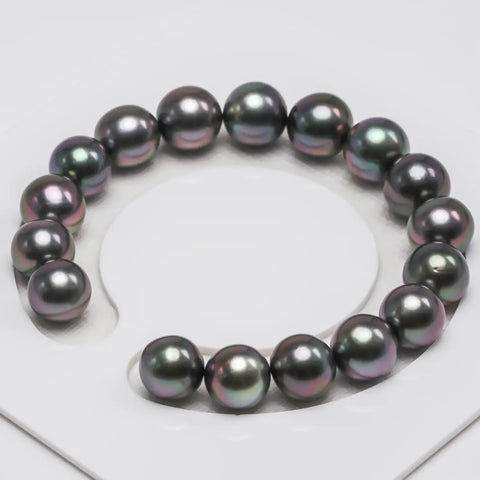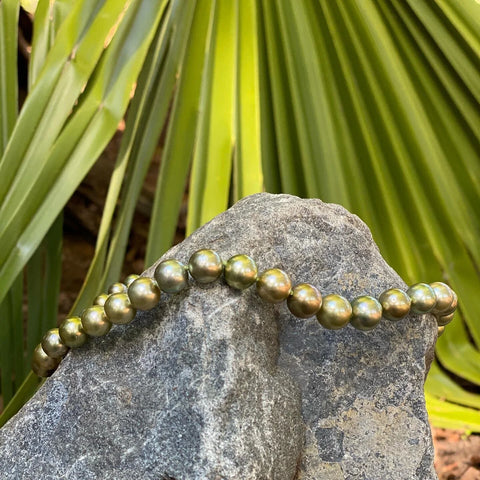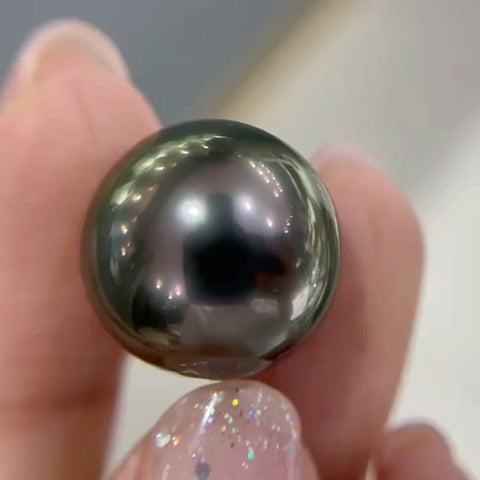
Hello, pearl enthusiasts and jewelry aficionados!
After a brief hiatus, I'm thrilled to delve back into the mesmerizing world of pearls.
Today, we're venturing into the exquisite realm of Tahitian pearls. This blog will not only enlighten you about their vibrant colors and logic behind their prices, but also immerse you in the captivating nuances that make Tahitian pearls a true marvel in the jewelry world.

The Power of Attraction of Tahitian Pearls: The Tahitian pearl, often dubbed the "queen of pearls," stands out in the pearl universe. As I looked through my collection, I realized that Tahitian pearls totally dominate it – a testament to their allure. They boast an unparalleled variety of colors and overtones, setting them apart from all other pearl types.
Although Tahitian pearls are referred to as "black pearls", their color palette is incredibly rich. But their spectrum is a kaleidoscope, ranging from silvery hues to deep, mysterious greens. The green Tahitian pearl, especially the "green peacock" variety, is a rare jewel, echoing the dark, iridescent colors of a peacock feather. The depth of its green determines its value, making it a coveted gem among collectors.

Purple Cherry Tahitian Pearls
The rarest and most sought-after shade of green Tahitian pearl is the "green peacock." Its description alone—greenish-black like a peacock feather—signals its rarity. A truly dark peacock pearl is among the most beautiful in the world and is extremely rare. The darker the peacock color, the more valuable the pearl. These pearls are often teardrop-shaped, rather than round, and range in size from 6 to 18 mm.
Other highly desirable overtones include blue, silver, gold, pink, and eggplant.
So, why is there a significant price difference between Tahitian pearls that are similar in characteristics (luster, roundness, surface cleanliness, size) but differ in color?
Let's start with the colors. In the pearl industry, there are commercial names for overtone colors:
- Cherry/Eggplant: Purple-black
- Champagne: Yellowish-gray
- Pistachio: Greenish-gray
- Lavender: Bluish-black
- Tahitian Gold: Goldish-black
- Pigeon Gray: Lilac-gray
- Silver: Gray
- Moon Gray: Pale-gray
- Gray Orient: Indicates an iridescent (Aurora) surface effect.

Dark Tahitian pearls with blue and green overtones
There is also a common discrepancy between market pricing and the professional grading standard of black pearls. For example, a professional primarily evaluates a pearl's luster, then its roundness, size, and degree of surface defects. As long as these factors meet the standard, the pearl's color doesn't matter to them.
But from a market demand perspective, when all other factors are equal, Tahitian pearls of purple-black (cherry), yellowish-greenish-gray (champagne and pistachio), bluish-black (lavender or magenta), and of course, peacock, are in higher demand.
The market response to this demand is reflected in the price difference among these colors.
A Rainbow of Overtones: The true magic of Tahitian pearls lies in their overtones. The most exquisite Tahitian pearls will definitely have a hint of peacock green (a combination of pink, blue, and green colors, plus a bit of gold). I assure you: you will pay twice as much for a pearl with such complex overtones, compared to other black pearls. By the way, green pearls are extremely rare in the wild.
Other highly desirable overtones include blue, silver, gold, pink, and eggplant.

A mix of cherry, peacock, and bronze overtones
Understanding the Pricing Puzzle:
So, why do similar quality Tahitian pearls vary so much in price based on color? The answer lies in their rarity and the demand for specific colors and overtones. While professionals focus on luster, roundness, and surface quality, the market responds strongly to color preferences.
But from a market demand perspective, when all other factors are equal, Tahitian pearls of purple-black (cherry), yellowish-greenish-gray (champagne and pistachio), bluish-black (lavender or magenta), and of course, peacock, are in higher demand.

The market response to this demand is reflected in the price difference among these colors.
Let's explore:
Gray Tahitian Pearl:

Dark Tahitian Pearl:
Priced 3-5 times higher than gray pearls of the same size and quality, these often have higher luster. Dark pearls grow in younger oysters, which produce better nacre and luster.

Black Tahitian Pearl with Dark Surface and Green, Purple, Blue Overtones:
These overtones are always stunning! The price of this type of black pearl is slightly higher than the second type and is mainly found in high-end stores and online luxury shops.

Black Tahitian pearl with a purple overtone (eggplant)
Dark Tahitian pearl with a pink overtone (light cherry)

Black pearl with a green overtone (emerald)
Tahitian Peacock Pearl:
Extremely rare and very expensive, priced 3-15 times higher than dark pearls of the same quality. They are mostly offered by a few high-end brands and suppliers catering to clients with high purchasing power.

Black Tahitian pearl with a bright green peacock overtone

Conclusion: The world of Tahitian pearls is a spectrum of elegance and sophistication. Their color and luster dictate their value, embodying a clear market principle: the rarity and beauty you pay for are unmistakable. Just remember: you get what you pay for.
Visual Delight: Attached are images of the finest Tahitian pearls - top or gem class. Observe the mesmerizing luster, a key factor in their valuation. Each pearl tells a story of beauty, rarity, and luxury, beckoning you to explore further into this fascinating world.

